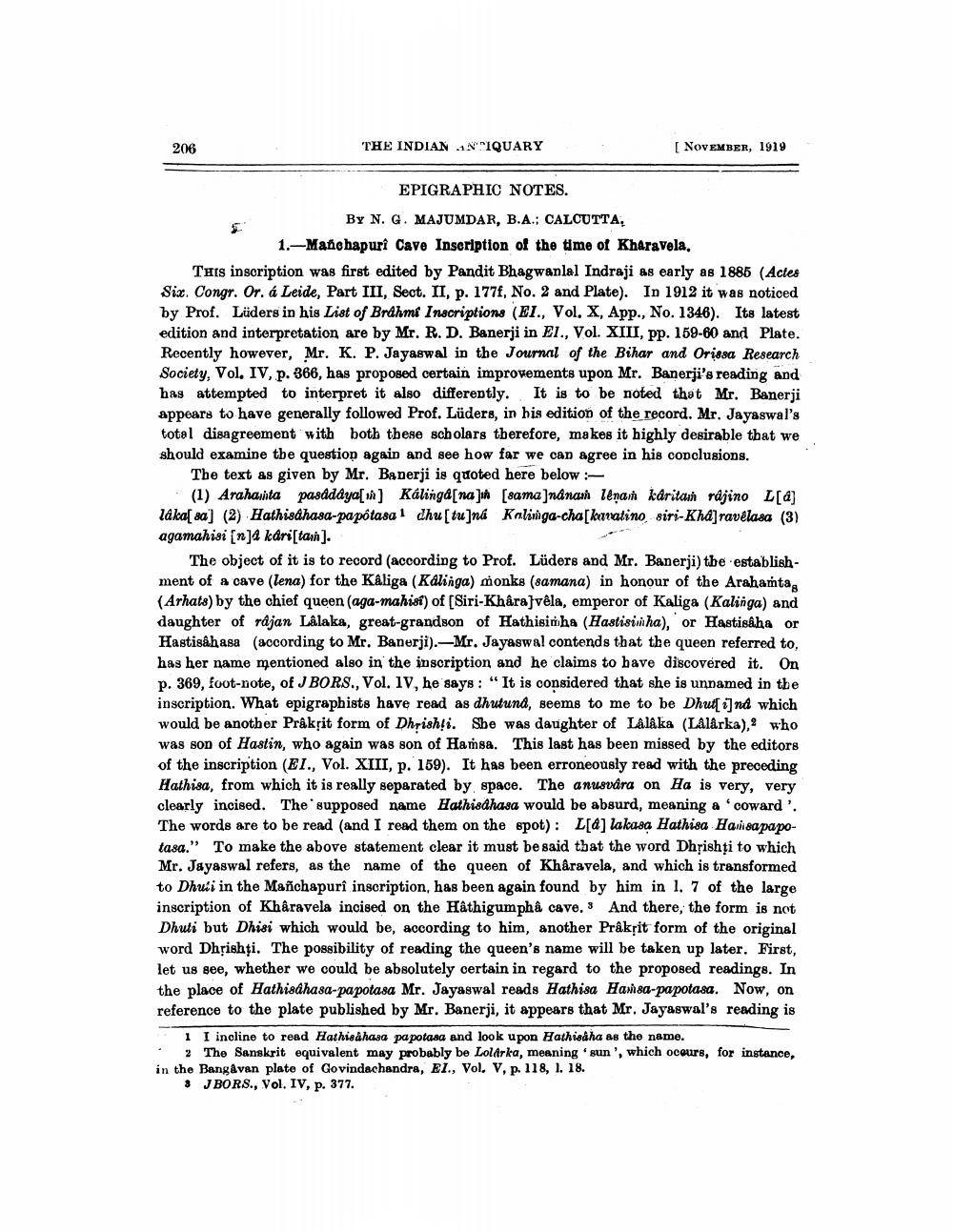________________
206
THE INDIAN NTIQUARY
[ NOVEMBER, 1919
EPIGRAPHIC NOTES.
BY N. G. MAJUMDAR, B.A.; CALCUTTA,
1.-Manchapuri Cave Inseription of the time of Kharavela. This inscription was first edited by Pandit Bhagwanlal Indraji as early as 1885 (Actes Six. Congr. Or. á Leide, Part III, Sect. II, p. 177f, No. 2 and Plate). In 1912 it was noticed by Prof. Lüders in his List of Brdhmi Inscriptions (EI., Vol. X, App., No. 1346). Its latest edition and interpretation are by Mr. R. D. Banerji in El., Vol. XIII, pp. 159-60 and Plate. Recently however, Mr. K. P. Jayaswal in the Journal of the Bihar and Orissa Research Society, Vol. IV, p. 366, has proposed certain improvements upon Mr. Banerji's reading and has attempted to interpret it also differently. It is to be noted that Mr. Banerji appears to have generally followed Prof. Lüders, in his edition of the record. Mr. Jayaswal's total disagreement with both these scholars therefore, makes it highly desirable that we should examine the question again and see how far we can agree in his conclusions.
The text as given by Mr. Banerji is quoted here below -
(1) Arahanta pasdddya[in] Kálinga[na juh (sama)nanaih Tenam kdritain rajino L[a] láka[ sa] (2) Hathisáhasa-papotasal dhu(tu]ná Kalinga-cha[karatino siri-Kha] ravēlasa (3) agamahisi [n] karistan).
The object of it is to record (according to Prof. Lüders and Mr. Banerji) the establishment of a cave (lena) for the Kaliga (Kalinga) monks (samana) in honour of the Arahamta (Arhats) by the chief queen (aga-mahisi) of [Siri-Khåra}vela, emperor of Kaliga (Kalinga) and daughter of rajan Lalaka, great-grandson of Hathisinha (Hastisiin ha), or Hastisäha or Hastiskhasa (according to Mr. Banerji).-Mr. Jayaswal contends that the queen referred to, has her name mentioned also in the inscription and he claims to have discovered it. On P. 369, foot-note, of J BORS., Vol. IV, he says: “It is considered that she is unnamed in the inscription. What epigraphists have read as dhutund, seems to me to be Dhut[i]nd which would be another Prakrit form of Dhrishli. She was daughter of Lalaka (LAlarka), who was son of Hastin, who again was son of Hamsa. This last has been missed by the editors of the inscription (EI., Vol. XIII, p. 159). It has been erroneously read with the preceding Hathisa, from which it is really separated by space. The anusvara on Ha is very, very clearly incised. The supposed name Hathisdhasa would be absurd, meaning a 'coward'. The words are to be read (and I read them on the spot) : L[a] lakasa Hathisa Havlisa pa potasa." To make the above statement clear it must be said that the word Dhộishți to which Mr. Jayaswal refers, as the name of the queen of Khâravela, and which is transformed to Dhuíi in the Mañchapuri inscription, has been again found by him in l. 7 of the large inscription of Khâravela incised on the Hathigumph à cave. And there, the form is not Dhuti but Dhisi which would be, according to him, another Prakrit form of the original word Dhộishti. The possibility of reading the queen's name will be taken up later. First, let us see, whether we could be absolutely certain in regard to the proposed readings. In the place of Hathishasa-papotasa Mr. Jayaswal reads Hathisa Hansa-papotasa. Now, on reference to the plate published by Mr. Banerji, it appears that Mr. Jayaswal's reading is
1 I incline to read Hathisähasa papotasa and look upon Hathisha as the name.
2 The Sanskrit equivalent may probably be Lolarka, meaning sun', which ocours, for instance, in the Bangåvan plate of Govindachandra, El., Vol. V, p. 118, 1. 18.
8 J BORS., Vol. IV, p. 377.




